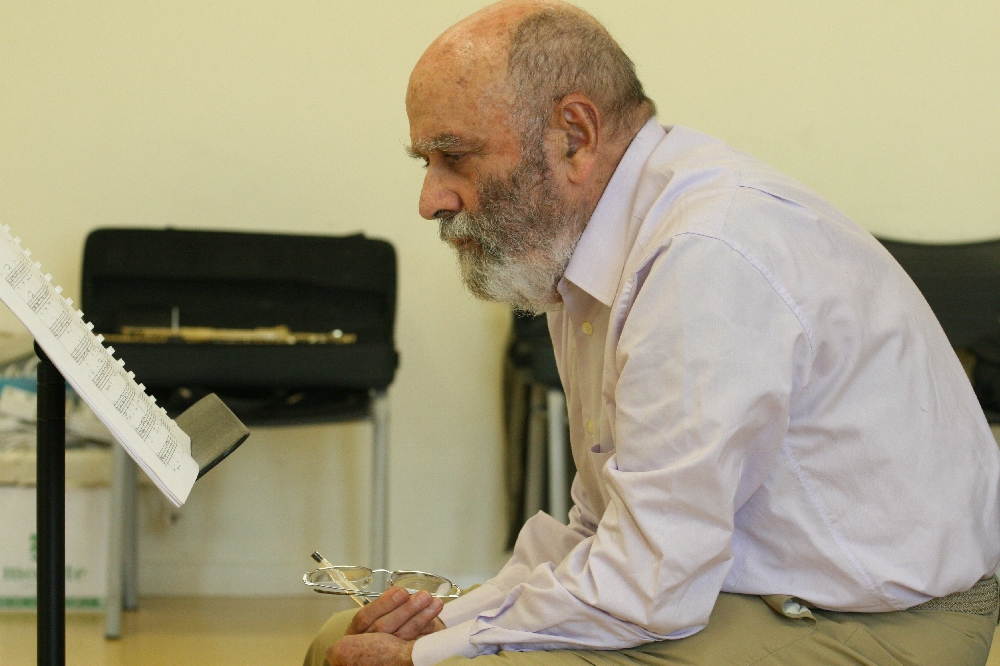This coming Sunday marks the 50th anniversary of the famous Encuentros de Pamplona.
This coming Sunday marks the fiftieth anniversary of the start of the famous Encuentros de Pamplona (Pamplona Encounters). From 26 June to 3 July 1972, the capital of Navarre became the most unexpected corner in which to offer a snapshot of the most innovative artistic creation of the time. And at its genesis was not a public institution, but a family of construction businessmen, the Huarte family, patrons of a project that also had its own name and surname, those of a Spanish composer, Luis de Pablo Costales (Bilbao, 1930-Madrid, 2021), who managed to bring Steve Reich and John Cage to Spain for the first time, the latter with the pianist David Tudor, as well as offering performances by Zaj, Jean Luc Ferrari and Jean Serge Breton, Sylvano Bussotti or Eduardo Polonio and Horacio Vaggione, in addition to showing the current affairs of the art world through the presence in Pamplona of Hélio Oiticica, Isidoro Valcárcel Medina, Equipo Crónica, Dennis Openheim or the performance artist Vito Acconci.
In Inventario (Casus Belli, 2020), the book of interviews between Luis de Pablo and the musicologist and lawyer Miguel Álvarez Fernández, the Spanish composer defined that event as “a revulsive, a kind of purification of blood”, and explained the origin of all that, which has become an unusual event – similar, with all reservations as to its duration and repercussions, to the Kassel documenta – which, unfortunately, did not sow any future seeds, having been born in the midst of Franco’s dictatorship.
“The Encuentros de Pamplona did not come about spontaneously,” De Pablo told his interviewer. “Don Félix was, besides the father of all the Huarte family, honorary president of the Provincial Council of Navarre because he dispensed money everywhere. When he died, his eldest son, Jesús Huarte, was offered the honorary presidency. At that time, I was immersed in the back-and-forth of the Alea concerts, and Jesús had become involved in the project […] One fine day he called me to tell me that he had been appointed president and that he wanted to give his people a nice present.
– What do you have in mind? I’ll give you no more than two or three days to think about it.
– I don’t need three days, I replied. Let’s do the same as in Alea, but in a big way, with a lot more than just music”.
With the sole requirement that it be held on the eve of the San Fermín festivities, De Pablo – with the help of his friend, the painter José Luis Alexanco, for the plastic arts section, and Pedro Esteban Samu, in charge of production, and of whom De Pablo himself said in the interview that he was “the one who really saved the Encuentros de Pamplona” – organised an eight-day event that was not limited to the Western artistic tradition, in which, in addition to musical performances of Western roots, others of diverse origins were offered: Iranian, Indian, Vietnamese, African, Polynesian or Amerindian, as well as from the indigenous Basque culture: the Encuentros began with a Basque pelota match and there was also a txalaparta concert by the Josanton and Jesús Artze brothers. There was also space for flamenco, performed by the flamenco guitarist Diego del Gastor and the Grupo Gitano de Morón. The non-Western music performances featured Hoseyn Malek, who gave a concert of Iranian classical music; there was also a combination of theatre, dance, song, music and acrobatics from southwest India, with the Kathakali of Kerala, as well as traditional music and song from Vietnam, with Trân van Khê.
But the lion’s share undoubtedly went to a powerful representation of the latest musical avant-garde. Horacio Vaggione and Eduardo Polonio performed IT, free electronic music with no other purpose than to show the concrete action of emitting sounds; Antonio Agúndez Leal and Francisco Guerrero performed Música para una ciudad. Promenade sur un parc; Sylvano Bussotti, leading the experimental trio Bussottihornungrocco, performed Las rarezas; Juan Hidalgo, Walter Marchetti and Esther Ferrer, members of Zaj, performed one of their concerts of action music, a silent music made with the help of a piano and non-sound objects: that is, visual, colourful and body movements with the aim of seeking the impossible game of visualising music. The mythical John Cage, father of conceptual and aleatoric music, together with David Tudor, offered Mesotics Re Merce Cunningham in the Sala de Armas of the Citadel; Jean Luc Ferrari and Serge Breton performed Allo, ici la terre; Steve Reich, who had the collaboration of Laura Dean’s dance company, performed on 1 July in the Palacio de Deportes Anaitasuna, full to overflowing, in one of the first performances of Drumming –premiered a year earlier– and in which, as a curiosity, the British composer and music critic Michael Nyman took part as a musician. Tomás Marco and José Antonio Fernández Muro offered Recuerdos del porvenir and, finally, Luis de Pablo and José Luis Alexanco presented their plastic-sound work Soledad interrumpida, in which, using tape recorders, electric organs, amplifiers and compressed air controls connected to inflatable dolls, De Pablo generated a sonorous cataclysm.
© El compositor Luis de Pablo, impulsor de los Encuentros de Pamplona. Fotografía descargada de Wikipedia: https://commons.wikimedia.org/wiki/File:Luis_de_Pablo.jpg
